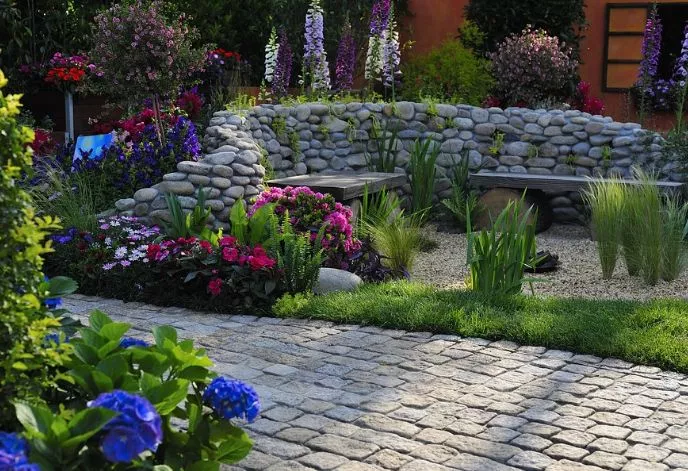8 Simple & Proven Steps to Level a Yard In 2023
Written by Ivy
Dec 15 2022

You probably already know how important it is to maintain your landscape's aesthetic appeal if you're looking for information on how to level a yard. Your outdoor environment is more stable if your yard is level. Additionally, it enables you to keep your foundation safe from serious harm and expensive repairs.
What is Yard Leveling?
In order to make your lawn flat and even, level your yard by removing or adding soil. Lumpy and uneven areas develop in your yard over time as a result of wear and tear and natural earth shifts. Uneven lawns can look bad and make sports like soccer and the like more challenging, among other issues. To level your yard, you only need some extra soil and some basic gardening equipment like a rake and wheelbarrow.
How to Level a Yard [8 Steps]
You are now prepared to grade your own landscape. To achieve excellent results, follow these 8 steps for grading a yard.
STEP 1: Mow Your Lawn
Mowing your lawn is the first step in yard leveling. Make sure to keep it brief. But take care not to make it too brief. Your grass may dry out if you cut it so short that you can see the stems of the blades.
STEP 2: Dethatch Your Lawn [As Needed]
By closely examining the roots of your grass, you can start grading the lawn in preparation for landscaping. Find out how much thatch is in your lawn.
Where the grass stems meet the soil and roots, a layer of thatch is formed from a mixture of living and dead plant matter.
Your grass won't receive enough water and air if there is more than 1/4 to 1/2 inch of thatch.
Remove the thatch if there is more than 1/2 inch.
A thatch rake is appropriate for smaller lawns. Use a dethatching device for larger lawns. which the majority of home improvement retailers rent.
STEP 3: Dig Up the Grass in the Sunken Area of the Lawn
Examine your lawn for divots and low areas that are deeper than 2-3 inches.
Do away with the grass covering them. To do this, position a shovel's blade on a low area's outer edge. In order to ensure you get under the grass roots, slide it down and under about 2-3 inches. Then use the shovel to lift the grass and remove the sod. allowing the dirt below to be seen.
STEP 4: Make Soil Mix: Topsoil, Sand and Compost
Make a top dressing mix to fill in the area beneath the grass in sunken areas of your lawn:
- 2 parts topsoil
- 2 parts sand
- 1 part compost
Your grass receives the nutrients it needs to thrive from the soil and compost.
Sand, on the other hand, does not compact easily. Over time, keep your yard level.
STEP 5: Fill Sunken Areas and Holes With Soil Mixture
Mix from step 4 should be poured into the third-step hole. Make sure to replace the grass on top of the holes once they have been filled.
STEP 6: Even Out the Entire Lawn
When you've finished filling in the divots and holes, spread the mixture evenly across your entire lawn, covering it by 1/4 to 1/2 inch.
Err on the side of caution and keep this layer thin. even if you believe you require more than 1/2 inch. You run the risk of choking your grass if you apply too much.
You can reapply in step 8 if you continue to feel like you need more.
STEP 7: Water the Lawn
To water your lawn, turn on sprinklers. As a result, your lawn will be revitalized and the soil mixture will fill in any air pockets in the grass.
accelerating the addition of fresh nutrients from the soil mixture.
STEP 8: Reapply Soil Mix [As Needed]
To level your yard completely, you might need to apply more than one layer of soil mixture.
When the grass starts to grow or the first soil mix layer can no longer be seen, you should apply the second layer by repeating steps 5 and 6.
You're done now. You are now aware of how to level a yard.
Reasons for Yard Leveling
Even if you have leveled your yard in the past, landscape grading may be needed in cases where bumps and lums are created by:
- Tree or brush removal
- Sewer installation
- Tree root growth
- Damage from animals
- Installation of new features (such as a pool)
- Settling
- Drainage issues
You should therefore keep an eye out for these indications that it's time to level your yard over time.

What Tools Do You Need for Yard Leveling?
Here is a list of garden tools that you'll need for your leveling project:
- Carpenter's level and stakes: Place four stakes in a square or rectangle-shaped area of the lawn, and attach string to the ends of each stake. Find the area of the lawn that needs leveling by comparing the line level and string level.
- Dethatching machine: At the turf, or surface level, of the lawn, there is thatch, which is decomposing grass and other organic ground cover. A thatch rake or dethatching machine removes the extra thatch, which indicates that your lawn isn't getting enough water if it is more than half an inch thick.
- Lawnmower: Lawn mowing is the first step in every do-it-yourself yard leveling project. If you cut the grass too short, it could dry out. Instead, cut it just enough that the stems of the grass blades are not visible.
- Lawn roller, rake, and shovel: Dig into low areas with the shovel to reveal the dirt that lies beneath the grass. After adding topdressing mixture to the divots, level the lawn with a rake or lawn roller. You can use a tiller to dig up the uneven areas if they are sizable enough.
- Topdressing mix: Sand, compost, and topsoil are combined to create topdressing mix, which is used to level out unevenness and fill in depressions throughout the entire yard. While the soil and compost provide the grass with nutrients, the sand keeps the lawn level.
How Do I Know If There is a Landscape Grading Problem?
Looking for standing water is the simplest way to determine whether your yard needs leveling. You can tell you have a problem if your drainage is poor.
You can gauge your yard's slope if you want to grade your landscape with more accuracy. To do this you will need the following tools:
- Hammer
- Two 3 ft. long stakes
- 100+ ft. string
- Carpenter's level
When standing a foot away from your home, the ground should slope away roughly 1/4 inch per foot. This equals about 2 feet. per 100 ft. Therefore, the ground should be two feet deep 100 feet from your home. lower than at the base of your home.
Grab a 3 foot ruler to precisely gauge the landscape grading slope in your yard. long wood stake. In the dirt at the base of your house, bury it one foot deep. Then, take a measurement 100 feet away from your home. Drive another three feet in that location. long stake into the soil.
Attach a string to the stake by the house at ground level. Go to the second stake with the string. The string level should be used to secure it to the stake. This can be done by using a carpenter's level.
Measure the space between the ground and the string on the stake that is farther away, which is attached to both stakes.
You might be able to level the ground yourself if the drop is between three inches and two feet. It is advised that you hire a specialist to grade the yard if the drop is higher than that or slopes upward.
Consider planting ground covers or constructing terraces for slopes that are extremely steep.
Things to Remember While Yard Leveling
For best results keep these tips in mind:
- Your yard should be leveled ideally during the dry season. If done during a rainy season there is a good chance for soil erosion
- The foundation backfill must be done correctly. If the soil is too close to the wall cladding then you risk termites getting into your house
- Any soil removed from the lawn can be reused while grading
Conclusions on Landscape Grading
To prevent long-term damage and exorbitant repair costs to your home and landscape, leveling your yard is crucial.
You can level a yard yourself by using the 8 steps listed above if your landscape grading problems are minor.
However, you should seek professional assistance if your lawn's slope is seriously causing you problems. They'll be able to level a yard with more complicated problems. Your landscape grading may require industrial-grade machinery and a trained eye to spot any issues.
How to Level a Yard FAQ
How to Level a Yard With Sand?
You can easily make your own lawn patching soil by mixing sand and dry topsoil in equal parts of half-and-half, spreading the leveling mix into low-lying areas of the lawn. Compost is a great way to improve the soil that some people also use. Just add 1.5 cm, or one-half inch.)
Why Should You Level a Lawn?
For a lawn to be happy and healthy, it needs to be leveled out properly. Due to the fact that your lawnmower won't be scalping the tops of the dirt, a level lawn is easier to mow. Furthermore, if the dips are uneven, the mower blades may go too low, cutting the grass very unevenly.
Standing water can grow in divots and holes in your lawn, which can lead to rot and other lawn diseases. There are thus many reasons to keep your yard as level and even as possible.
When is the Best Time to Level Your Yard?
There is the best time to level your yard, just like there is for the majority of other landscaping projects. The best season to level your yard is typically spring. This is due to the ideal combination of dry and moist soil conditions in the soil, as well as the fact that your grass has already had some time to grow for the season. The grass is at its healthiest and most resistant to landscaping efforts when it is in its active stage in the spring. In colder climates, leveling your yard in the summer shouldn't present too many difficulties.
Latest Updated
- Benefits of Bugleweed - 7 Science-backed Health Benefits
- Bugleweed Dangers & Side Effects - Is It Poisonous?
- How to Plant Evergreen Trees - What You Should Know
- When to Plant Evergreens - Grow Guide for Evergreen Trees
- 12 Wonderful Evergreen Shrubs for Your Garden
- 12 Popular Evergreen Plants with Pictures for Beginners
- When And How To Prune A Lilac Bush Like a Pro
- How to Grow & Care for Lilac Vine (Hardenbergia Violacea)
- Japanese Lilac Tree (Syringa Reticulata) Care & Propagation Guide
- Shumard Oak Pros and Cons - What to Know
Popular Articles
- Winter maintenance of Antirrhinum Majus
- How to Grow Terminalia Mantaly Tree
- How to Grow and Care for Crossostephium Chinense
- How to grow Antirrhinum Majus in spring
- Peristeria Elata (Dove Orchid) Profile: Info & Care Guide
- Underwatered Snake Plant (Sansevieria Trifasciata) - Signs And How To Fix
- How to Care for Brazilian Jasmine Plant (Mandevilla Sanderi)
- How to Grow & Care for Graptopetalum Purple Delight in Summer
- Rosa Chinensis (China Rose): Plant Growing & Care Tips
- How to Care for Baby Sun Rose (Aptenia Cordifolia)